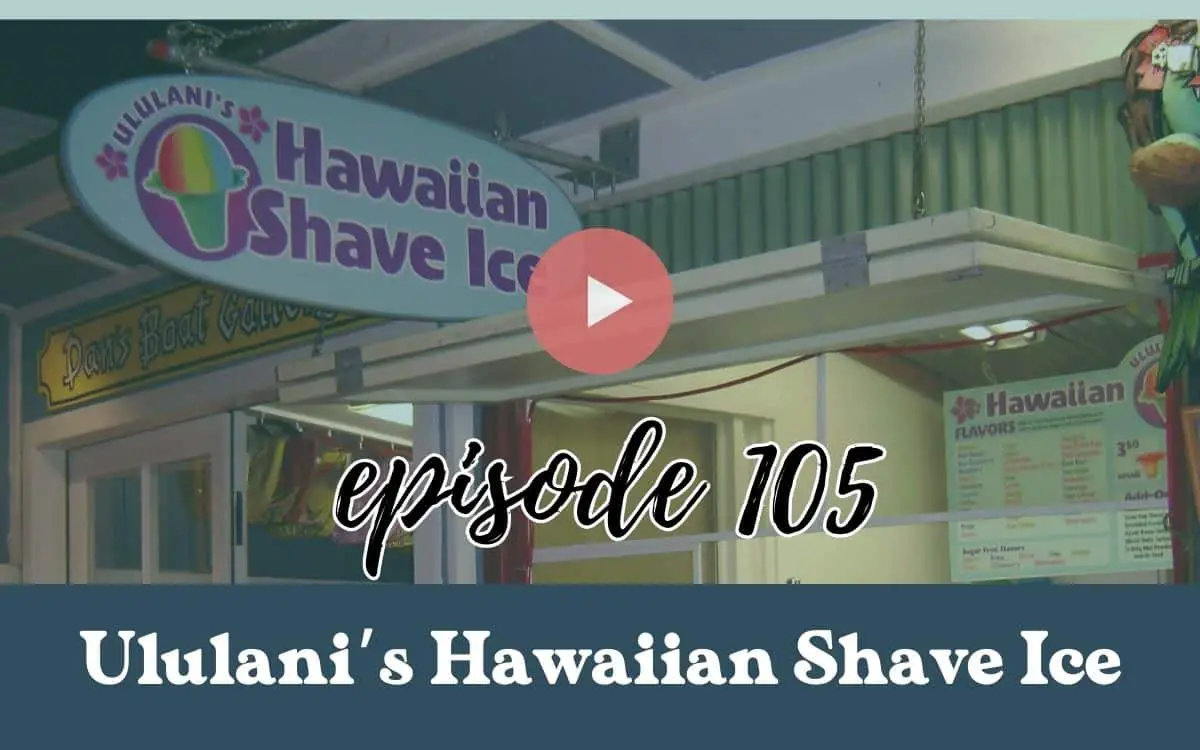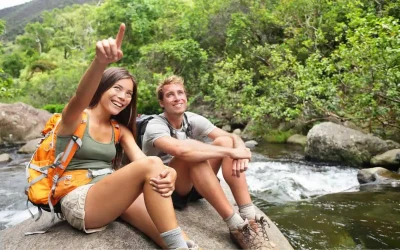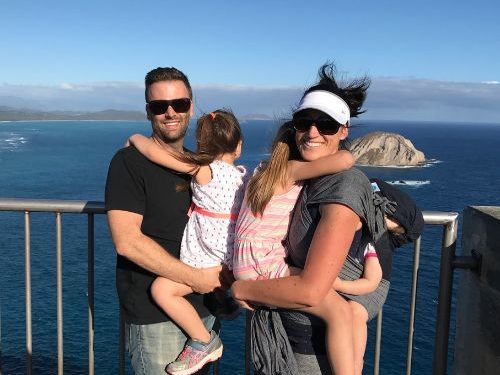Episode 105: From Lahaina to Texas: Ululani’s Hawaiian Shave Ice’s Journey of Strength and Flavor

David Yamashiro, co-founder of Ululani’s Shave Ice, joins the show! We dive deep into the after-effects of the fires on Maui regarding tourism and the livelihood of the locals.
Planning a trip to Hawaii? Have any questions? Join our Hawaii’s Best Travel Facebook group here now! It’s the perfect place to ask any questions and to be inspired!
This post may contain affiliate links, meaning that I may earn a commission if you use a link provided.
This post gives general info and isn’t legal or authoritative advice. It helps travelers with tips but can’t replace personal abilities, fitness, experience, or local knowledge. Marine activities have risks; assess conditions and follow local laws.
The dialogue uncovers the resilience of Lahaina’s community, Ululani’s continued commitment to help, and the importance of supporting Maui’s other untouched regions.
What we discuss with David Yamashiro:
- Economic strain on locals relying on jobs within the tourism industry.
- Ululani’s commitment to aid the affected community.
- Introduction of new Ululani’s locations.
- Details about the GoFundMe initiative for relief efforts.
- Appeal to tourists to continue visiting parts of Maui besides Lahaina.
- Challenges of rebuilding Lahaina and uncertainties about its future layout.
Listen On:
Resources
Blog Article: Can you visit Maui right now?
Find out more about today’s guest…
- Uluani’s GoFundMe Page
- Uluani’sWebsite
Self-Guided Island Tours
- Episode 70 – How to Volunteer in Hawaii
-
Episode 87 – How to Travel Responsibly to Hawaii
-
Episode 35 – 5 Things to Not Do in Hawaii
Travel Pono (responsibly)
Connect With Us
- Buy Me a Coffee
- Send Us a Message with any questions about Hawaii
- Hawaii’s Best Instagram
- Join our Hawaii’s Best Travel Facebook group here now! It’s the perfect place to ask any questions and to be inspired!
Bumper music, Ukulele and Chill, provided by Coby G (used with permission)
Bumper music, Aloha Friday, provided by Clay D (used with permission)
Spread Aloha
- Leave an honest review on Apple Podcasts
- Follow the Show on Apple Podcasts
How Did the Renovation of The Westin Maui Resort and Spa Contribute to Creating an Authentic Hawaiian Experience?
The westin maui resort spa renovation played a significant role in achieving an authentic Hawaiian experience. By incorporating traditional elements in the design and décor, guests are immersed in the rich Hawaiian culture. From the stunning ocean views to the lush gardens, every aspect contributes to the overall ambiance and authenticity. With upgraded amenities and refreshed rooms, the resort offers a perfect blend of modern comfort and genuine Hawaiian charm.
Related Posts
Top 10 Best Reef Safe Sunscreens for Traveling to Hawaii
[dssb_sharing_button social_network="pinterest" _builder_version="4.24.3" _module_preset="c7f34e9f-6993-48b8-918d-312481fc55be"...
17 Unique Kauai Cultural Activities and Traditions
[dssb_sharing_button social_network="pinterest" sharing_message="custom_message"...
5 Ways to Travel Responsibly to Hawaii: A Guide to Ethical and Sustainable Tourism
[dssb_sharing_button social_network="pinterest" sharing_message="custom_message"...
Bryan Murphy: 0:00
Coming up next on Hawaii's Best.
Holly Sevier - Friends of Ha'ikū Stairs: 0:03
The stairs were first built in. 1942 is when they started to build them Right after the attack on Pearl Harbor, as they realized pretty quickly that they were going to join the Pacific War and they realized that they needed better radio telecommunications, and so that was originally why they were situated in the valley.
Hawaii's Best: 0:24
Aloha. Welcome to Hawaii's Best. Here you'll learn what to know before traveling, as we discover Hawaiian culture, local businesses and the experiences that make Hawaii one of the most incredible places in the world. And now your host, brian Murphy.
Bryan Murphy: 0:42
Today on the show we're talking about the famous Haiku stairs, also known as the stairway to heaven or the Haiku ladder. It is an incredible steel structure on the island of Oahu and it once served as a route to reach a former US Navy communications facility. This construction, boasting over 3000 steps, stretches across Oahu's breathtaking Ko'olau mountain range and throughout the years, it has served as a hiking trail. However, it is currently not open, so if you were to hike the stairs, it would be considered trespassing. No matter which way you go about it, or you get to the structure, as soon as you get on the structure, it is considered trespassing, so please know that. But in 2021, the city council of Honolulu cast a devote in favor of the stairs removal, and that's kind of where our story starts today. And today on the show we have Holly Sevier, who is the vice president of Friends of Haiku stairs, and she's going to discuss the rich history of the stairs, including the period of time of what manage access to the stairs was like as a hiking trail. A lot of our conversation is around the controversy of the stairs, along with many solutions that the Friends of Haiku stairs have put forth for manage access and a little overview of the Friends of Haiku stairs. They are a nonprofit dedicated to protecting the iconic Haiku stairs and its environment since 1987. Responding to the city's threats of destruction, they recalibrated their mission passionately, and you'll hear that from Holly. Friends of Haiku stairs, or FHS, is a tapestry of people from various walks of life, including engineers, gardeners and students, all bound by shared passion. With the community support, fhs is working on solutions that put their community and the IANA or land first. They're also collaborating with local stakeholders to foster stewardship for the entire Haiku valley, nurturing an ecosystem that strives from mountains to the ocean or Malco to Makai. Since my conversation with Holly a few months back, the city of Honolulu has continued with its plans to dismantle the stairs and, in response, the Friends of Haiku stairs are filing a lawsuit to halt the removal, complaining an insufficient environmental review was carried out. In addition to this, the Kaneohe neighborhood board has been diligently reaching out to local communities, assessing sentiments around trespassing near the stairs. Many residents reported no issues with trespassing and, in fact, they noted that such incidents have declined in recent years. Many residents also have demonstrated overwhelming support for the preservation of the stairs and they believe in a future where the stairs are not only saved but also reopened under managed access. The city of Honolulu received just one bid to dismantle, destroy the Haiku stairs, and that bid happened to be from the very contractor who was paid nearly a million dollars to make the stairs public ready in the early 2000s. Now the same contractor is offering to take down the same structure for 2.26 million dollars. So why does this all matter? If you're a voting resident of Hawaii and would like to see the stairs preserved, well, I would encourage you to sign the petition at HaikuStairsorg. We'll leave a link in the episode description. However, I know the majority of you and why this podcast exists aren't residents of Hawaii and you're looking for tips to plan your trip and just getting a little bit of understanding of what to expect on your trip. And I know that the stairway to heaven is on a lot of people's bucket list to hike. So helping to support, manage access to the stairs is a great way to help this cause. And but maybe you're not a hiker or have no idea, maybe the first time you're hearing of the Haiku stairs. Well, holly discusses the unique history of the stairs, built 81 years ago in response to the war efforts in the Pacific. She also offers some great tips towards the end of our conversation for first time travelers. So stick around for this one. It's a great episode and let's go ahead and let's talk story with Holly. Let's talk story, let's talk story.
Holly Sevier - Friends of Ha'ikū Stairs: 4:57
Let's talk story. Oh, Holly Sevier, kuhui noa no ho al ma Haiku on Oahu. So my name is Holly Sevier, I'm the vice president of Friends of Haiku Stairs and I live in Haiku Valley on Oahu.
Bryan Murphy: 5:14
Holly, thank you so much for your time and coming on the show today. How are things on the island of Oahu?
Holly Sevier - Friends of Ha'ikū Stairs: 5:20
It's a beautiful day here, bright and sunny, with good breezes.
Bryan Murphy: 5:23
Awesome and I know you've mentioned you've lived in the valley for about 20 years. What brought you to the valley?
Holly Sevier - Friends of Ha'ikū Stairs: 5:31
Yeah, so, as you might be able to tell from my accent, I'm actually English. I grew up on a small farm in England and I moved to Hawaii about 20 years ago with my kane, my husband. We moved to the valley. I was actually pregnant and we were lucky enough to be able to buy a house in the valley and my son just turned 18. So that's how long I've lived there in that house, and from most of my house you can see the stairway in the background. So that kind of drew my attention from very early on.
Bryan Murphy: 6:02
That's awesome and, yeah, today we're talking about the stairs, the stairway to heaven and all the other infamous names. Give us a little bit of where their little kid I know you mentioned in the valley, but just someone who's maybe driving on H3 is probably a good marker on how to spot the Haiku stairs.
Holly Sevier - Friends of Ha'ikū Stairs: 6:22
Yes, if you are driving on the so-called Interstate, h3 in Hawaii would not go interstate. It rips right through the Kotolau mountain range and it's quite an impressive looking freeway. It's on stilts and it comes out through Haiku Valley and on the right hand side as you're driving, you can see the Haiku stairs pretty close by as you're driving. The stairs were first built in 1942 is when they started to build them right after the attack on Pearl Harbor, as they realized pretty quickly that they were going to join the Pacific War and they realized that they needed better radio telecommunications, and so that was originally why they were situated in the valley. It has a really unique topography. The valley is in the Ahupua of Heia, which goes from the top of the mountains down to Mokapu Peninsula, where the Marine Corps base is today, and the valley is almost amphitheater shaped. It's got very, very steep walls, rising to about 3,000 feet and on three sides, so it creates this kind of horseshoe that they realized they could use to amplify a radio signal. So what they did was to brave young men, bill Adams and Louis Otto. They spent three straight weeks climbing that mountain, pegging it as they went with three-foot steel pins and then returning when they ran out of pins at the end of the day and in three weeks they had reached the top of Pu'u. Keahi Akohoi, which is the Hawaiian name for the mountain. It translates to Pu'u, is a big peak or hill. Keahi Akohoi means the fire of Kohoi and that relates to an old Mo'olelo or story about a taro farmer who used to live in the valley. The valley was always very rich in the past with taro. Then the military kind of swept in in the 40s and pretty much raised the valley to the ground, cut down all the native plants, used bulldozers in the building of the radio station and associated buildings that were needed to run it. So the stairs we used to get to the top of the mountain and then a cable was strung across the valley and the radio signal was amplified using an Alexanderson alternator which side that in the Omega station in the middle of the valley. So it was an amazing technological feat that they were able to create this very low frequency radio signal and it was actually able to reach submarines in Tokyo Bay. Oh, wow, this was pre-satellite, very, very early telecommunications. We had a hugely inventive and it actually worked. So it was a really integral part of the war effort for America and the Second World War.
Bryan Murphy: 9:06
That's incredible. I didn't realize all that in all the details. I knew the valley is a special valley on many different levels, but the innovation that happened there as well with this build when was it decommissioned by the military?
Holly Sevier - Friends of Ha'ikū Stairs: 9:21
Yeah, so it was used during the war. In the 50s they replaced the wooden steps with metal steps and then satellite telecommunications came about and so it was no longer needed and so they dismantled the antenna and the cables and so forth, but the stairs remained and they were used until about 1987 when the property was actually handed over to the Coast Guard, and they were then for a long sorry, it was before that, but for a long period you could just rock up at the Omega station, sign a liability waiver, head to the base of the stairs and climb them, and then in the 80s they were closed. So Friends of Haikus Stairs was created as a response to that in 1987, and the Friends Job was routinely to go up there and make sure the structure is in good shape. It's 3922 steps all made of steel, diamond hatch, steel, non-slip tread, and the structure is modular. So it has about 600, just under 600 modules. So we would go up there routinely and legally and we would tighten bolts, replace any rusted parts and keep the structure in generally good shape, and then we would also do invasive species removal work. So there are some super rare plants endemic to the Kutlau range, to the right, next to the stairs, plants such as Traumatolabilia, and so we would weed around those plants to allow them to thrive and then also really try and make headway on two of the big invasive weeds that we have in the valley the Shaflora or Hei octopus trees that you see these bright red fluorescences you can see, though, that are spread by birds and then Clydemia, which is a little climbing weed that strangles everything. So we would routinely go up there, remove all of those plants, remove any trash, graffiti, stuff like that, just keep those stairs in good shape. And then, about 2015, we would disallowed from doing that work. So, even though we had permission, we had liability waivers and insurance, they stopped us from doing volunteer maintenance.
Bryan Murphy: 11:31
Had to kind of be our little pause right there and kind of bring us up to present. But back in 87, there was a time when people were able to sign a waiver and do the hike legally. Is that what I'm saying?
Holly Sevier - Friends of Ha'ikū Stairs: 11:42
Yes, yeah, yeah, and thousands of people climbed the stairs safely during that period. There was never a report of a fall or a serious accident, and certainly in the 80 year history of the Haiku stairs, there's never been a death as a result of a fall. And there's also never been a lawsuit in that entire time. Interesting, and that came up recently during city council meetings and they said it's a liability, and so we asked how many lawsuits have you had since 1942? And the answer was zero.
Bryan Murphy: 12:12
Where do you think that story or that narrative has been? Where did that start? Basically, the liability of the stairs.
Holly Sevier - Friends of Ha'ikū Stairs: 12:24
Right. So stairs are dangerous. All stairs are dangerous, and if you go to the CDC website, you'll see that five people in Hawaii every year die falling down their own stairs. So when you look at a structure like the Haikyoku stairs, when you see pictures of it, it looks terrifying to some people and because it looks scary and many people are afraid of heights, they just assume that it is dangerous. But of course it has handrails either side. These handrails were put in at enormous expense. In the early 2000s. The city spent almost 900,000 making the structure solid, replacing any bits that needed replacing, shoring it up, putting handrails in, putting guardrails around the concrete platforms that helicopters use, to make it safe for public use. And then it wasn't opened after that and what happened is that everyone knew it was fixed and safe, but there wasn't a legal way to access it. So people started trespassing to get to it and that started causing all sorts of problems, because some people who live in the community have people walking through their yards every night and that's completely unacceptable and makes quality of life really difficult for some people who live next to access points. But the stairs aren't in themselves dangerous. As I say, they have handrails either side, and so when you compare them to any other hike on the island, they are the safest. I mean, just in the last seven days there's been a serious fall from a trail in Hawaii and I always pay attention to those reports, and certainly we pay very, very close attention to any report of an accident or a rescue from the stairs and what we usually find is that they report it as a stairs rescue, but actually they're using the concrete platforms to do rescues from across the Kuala Lumpur Range, but people will see helicopters near the stairs and then they will just report it as another stairs rescue. Right, there's a lot of misinformation out there. Misinformation plus people's own personal fear of stairs makes it seem like the hiking stairs are the scariest staircase on earth. I've climbed them legally maybe six or seven times and it's quite intimidating. There are two sections in particular that are almost vertical, so like climbing a ladder and in fact it was originally called the Haiku ladder when it was first built you have to turn around and climb down backwards as you would on a ladder, and you're at about 2000 foot elevation doing that. So it's quite scary, but let me tell you you hold on real tight.
Bryan Murphy: 15:12
Those instincts? Yeah, they kick in. Yeah, what? Yeah, I mean, at least I've seen a post about the Haiku stairs, or the stairway to heaven, as some people refer to it. Yeah, you just got to go the legal way. Just go the back way, go the legal way and it's fine, you'll be good. Let's debunk that a little bit. Talk about what quote unquote the legal way is but isn't, and what is the current? And that kind of brings us up to speed here it's currently illegal and what happens if you get caught. So, back up a little bit and talk let's talk about it. What is the quote legal way that people talk about?
Holly Sevier - Friends of Ha'ikū Stairs: 15:51
Right. So I wouldn't call it a legal way because it's a mountain and it shouldn't be either legal or illegal to walk on a mountain. It's public land. Got it Route from Mauna Loa Valley is, and I've done it a couple of times with a professional climbing friend. It's extremely treacherous and it is an unsanctioned trail, which means it's not maintained in any form. And having done it I used it's extremely technical. I used technical gear to climb it, but there were many, many people I saw that day who were climbing it unprepared. It is perhaps a six to eight hour hike there and back. As soon as you step onto the high coost air structure itself, it's considered trespassing and you're liable for up to a $2,000 fine. So the trespassing is an illegal act, but climbing a mountain itself is illegal activity as long as you do it safely and responsibly and respectfully. If you go early in the morning, you're going to have to park in a residential neighborhood and that means maybe doors slamming and people talking, and I'd hate to disturb any neighborhood in Hawaii, which is a very quiet and special place. So that would be my caveat to anyone wanting to climb any mountain in Hawaii is go with a professional. If you're not well equipped? Get well equipped. We wore hiking spikes and I had poles with me because you got to the top of the mountain. It's cold up there. The elevation makes it pretty cold. You don't expect that because it's the tropics. You have to be prepared for that. You also have to be prepared for very rapid changes in weather. When the friends would do maintenance days, we would have a weather spotter at the base of the stairs whose only job would be to look at rain coming in on a satellite radar and to alert us with walkie-talkies to come down in advance of heavy rain coming in. That tells us seriously. We took the weather, and that was with handrails. So for people climbing the mountain any mountain in Hawaii you have to be really attuned to what the weather is going to be like.
Bryan Murphy: 18:02
So let's go back to 2015 and what that ruling was and talk a little bit about the response of friends and what maybe kind of bring us up to speed today and what the initiative is.
Holly Sevier - Friends of Ha'ikū Stairs: 18:16
Yeah, so 2015, the Board of Water Supply found out that they owned the stairs. They didn't know that they owned it. Oh, they didn't even watershed property. So they found out they owned it. And then they were immediately worried about liability because they believe it's dangerous. And so, even though we have, as an organization, a million dollars insurance for climbing and doing maintenance, they disallowed our volunteer maintenance use of it. So when we climbed, we would get permission from all of the landowners. We would also notify the police department and the fire department just to let them know that we were up there. So that 2015, the Board of Water Supply disallowed our maintenance use. And then they turned around and did an EIS an environmental impact study with the idea to remove. So that was the only way they could think of to reduce their liability, because the Board of Water Supply stated that their mission is just to produce water, not to produce hikes or not to give access to hikes, even though the Board of Water Supply earns a lot of crime hiking real estate in Hawaii. So they did the EIS and actually the outcome of the EIS was it would be cheaper to keep her as the saying goes. Cheaper for the city to fix the stairs and hand them over than it would be to remove them, even though that was the outcome. So they then gave the land to the city and county of Honolulu and the city and county then put out a request for RFI, request for information from anyone wanting to open the stairs, and something like 16 companies from across the state wrote in with information, something like a proposal to run them, and then the city did nothing further with that. They never went to the proposal stage and instead they just turned around and slipped this $1 million in a capital improvement budget to destroy them. Of course you can't destroy historic structures with capital improvement money, so then they had to put it in a different budget and then the amount went up to $1.3 million. No explanation as to the 30% increase. There were rounds of council testimony and thousands of people wrote in and gave testimony and the city council ignored a lot of it, saying that it was outsiders. We had interns, legal interns, pour through all of that testimony and about 93% of it was local and about the same amount was in favor of keeping the stairs under managed access. So the claims they made, they kept changing the claims. The city council. They said it was a liability, and then we pointed out there had been no lawsuits and they said oh, it's trespassing, that's a liability. So they kept sort of switching their story and then they unanimously agreed to spend the money and the mayor said, yes, good idea. And then, as far as we can tell, there really haven't been any further concrete steps towards removal.
Bryan Murphy: 21:18
As far as in the timeline. When was this whole decision?
Holly Sevier - Friends of Ha'ikū Stairs: 21:22
It's been a couple of years, so it coincided with the pandemic and, but you know it's also right now, at the likely beginning of a recession, probably not the time to be spending what could be $10 million on removing a piece of history in its 80th anniversary year, especially when there's many more pressing things that the Hawaii needs to spend money on. Again, we're in a kind of limbo. The limbo continues, which is bad news for the neighborhood.
Bryan Murphy: 21:51
Yeah, maybe just love to hear about the neighborhood and the voices of the neighborhood and what would be their ideal as a community to see what happens with the stairs.
Holly Sevier - Friends of Ha'ikū Stairs: 22:03
There's about 100 acres in the valley that right now is mostly owned by the Department of Hawaiian Homeland. They have no plans to build homes there because access to the back of the valley is pretty constricted, and so they've been holding onto that land as some kind of bargaining chip. What it means in the meantime is that invasive species have grown rampantly throughout the valley. There are organizations who do invasive species removal work in the valley. Kotolau Foundation is the prime organization who go in there routinely every month with tools, and I've joined them as a volunteer Remove invasive species bamboo that really needs to be dug out and burned. And the Kotolau Foundation have a wonderful plan for a cultural park in the valley that would include areas for growing native plants and healing plants and plants for hula, restoration, watering space A really beautiful plan. They've always envisioned that the stairs would be part of the plan, because the stairs are there, not because they're of great fans of the stairs, but the stairs exist as a resource and they realized that we would happily, if any money were made on the stairs, give any proceeds to the Kotolau Foundation so that they can build their cultural park. The Friends of Hattiku Stairs has absolutely no financial interest in the stairs. We've been at all volunteer organizations since 1987, but really many of my neighbors. I live right in the middle of the valley. I've been a neighborhood board member for 11 years there. Many of my neighbors would like to see a park but would not want to see heavy traffic. The streets are pretty narrow leading up to the back of the valley and not suitable for buses or anything like that. During the EIS they did suggest building another road to link up to the valley. The H3 access road is a separate road that goes underneath the H3 and is not used by anyone. That's owned by the Department of Transportation. It actually leads to a third tunnel that goes straight through the mountains. It could be an amazing recreational tunnel for cyclists and so forth. All we would need to do is link up a road to the H3 access road or drive through it from the other side, and we would be in the valley without disturbing any of the neighbors. So there's definitely ways to make it work and there have been plans out there for years and it's just nobody's moved ahead on it and meanwhile some of the neighbors suffer and people who would like to use the valley for recreation or for growing plants just can't.
Bryan Murphy: 24:40
Interesting, so that access road would be kind of the gateway into the trailhead of the stairs basically.
Holly Sevier - Friends of Ha'ikū Stairs: 24:49
Yes, the H3 access road leads directly to the base of the stairs. In fact, if HPD really wanted to catch trespassing hikers, they would just simply need to get their horses on that road. They never have. They never have. Instead, the city pays about 350 grand a year for off-duty police officers to do extra shifts, driving around my neighborhood at night looking for people who might be going for a hike, which is a ridiculous situation because unless you've witnessed someone trespassing, you can't actually ticket them to trespass.
Bryan Murphy: 25:22
So what to be done then, like how, what's the response, what does moving forward look like? And then what's the most idealistic outcome? I know you kind of alluded to it a little bit, but where's the light, where's the? What can we help, work towards and partner alongside of you?
Holly Sevier - Friends of Ha'ikū Stairs: 25:41
Yeah, we need. We're raising money to do things like fund drone footage so that we can prove there are still federally protected plants nearby. Federally protected plants means they have to do a federal EIS, which is a whole different level of permits. They have to do an accidental take permit if they're going to do any kind of construction near a rare plant. So we're really rallying to, first of all, let people know that the fight is still going on, but also to prove that removing the stairs would be some kind of crime. So what can, what can people do? Your listeners? They can go to our website, hikeystairsorg and learn more about the history and find out about our fundraiser and our information events that we have. I would urge people to to any kind of hiking, to hike responsibly and respectfully and to absolutely do not trespass in order to reach the stairs, as that just fuels the the fire and removal, yeah.
Bryan Murphy: 26:42
So, as a nonprofit, when somebody gives, or, like myself, I just bought my t-shirt so someone financially gives to the nonprofit that goes towards this legal team. That's one of the things. So that's just kind of what people can expect where their I guess their resources would go towards.
Holly Sevier - Friends of Ha'ikū Stairs: 26:59
Yep, the board is 100% volunteer, and so let your folks know that we all volunteer our time. And yeah, another thing that your listeners can do is if they see stories on Facebook and Instagram New stories is they can add their voice to the comments. Unbelievable although it may seem. Although the city council and elected politicians do not seem to listen to council testimony, they do read comments on social media. So it's a. It's a weird way that democracy works, but there you go. You can enlighten people. Zero deaths, zero lawsuits in 80 years. That kind of little comment or direct them to the history on our website so people can actually know is really a useful part of the discourse.
Bryan Murphy: 27:43
If he had your magic wand and you could just wave it, and then tomorrow, everything would be. How would you see that reality? What would that look like for you?
Holly Sevier - Friends of Ha'ikū Stairs: 27:52
Yeah, I think our magic wand has half been waved, because Josh Green is the new governor of Hawaii.
Bryan Murphy: 27:57
He's a supporter of it, yeah.
Holly Sevier - Friends of Ha'ikū Stairs: 27:59
He's a supporter of Hawaii Custair. Yes, at our very first information table at Kakaako Farmers Market, he was our first customer and he wanted to learn all about the history. He was fascinated by the history and he wanted to learn. He wanted to know how he could help. Okay, so that was music to my ears. Two more years likely will get a new mayor, and so if we can hold on for two more years, if we had a mayor who was pro-stairs and the mayor and the governor shook hands, we would be back up there the next day, Legally, with our permits and with our insurance and our liability waivers. We had a very rigorous way that we used to climb. We didn't, you know, we wasn't happy at all. We were very planned out. Yeah, so the mayor and the governor shaking hands, that was all it would take for this to be back open again, and you know we as an organization have always fixed it for free, using volunteer labor and donated materials, funds. We would, we would pay 100% to to restore the stairs. Currently, there's about eight modules that have been damaged since we stopped repairing them, and so we would go in there and it would take us, you know, a few weeks, depending on how often we were allowed to work on it. We pair again and then as an organization, we would also adopt all of the liability. So if the city worries about liability as that, they could just lease the structure to us and the president of our organization is actually a law professor, so I'm pretty sure he can figure out a way to that we would cover the liability. In all the years that we worked on the stairs we as an organization never had an injury or a serious accident, so we have a really really good track record of reaching volunteers up there and Of doing maintenance work on the structure itself. And on our board. We have doctors, lawyers, we have an engineers, as he's actually a forensic engineer. All he does is look at buildings that have fallen down, so he knows structurally exactly. You know what, what it's supposed to look like. Oh, so we have. We have really a good team of experts and other people that use it, so we have. We've done in the past a couple of botanical studies, so you've taken botanists up there from the Bishop Museum. In terms of recreation, it's a fantastic and hard climb, but for a plant nerd like me, it's absolutely worth it. You can see amazing native plants like oh here lehua, at all its Elevations. Within about an hour and three quarters it takes to climb from bottom to top. You can see or hear at all the different elevations. It looks different at different elevations, so it's a it's a really amazing way to be able to study the plant and safely Using the staircase, which really doesn't disturb anything around it. There's no erosion near the stairs Because people stay on the staircase, they use the handrails, whereas erosion Anywhere else in the corralel range that's heavily trafficked is pretty bad. That's another reason I would caution people against doing the so-called back route is that it is not only an unauthorized and unmaintained trail, but in just climbing it you contribute to what's a really, really serious erosion problem. Got it but because there's no erosion, so that that structure leaves the plants intact.
Bryan Murphy: 31:18
You mentioned something. I think I'm kind of reading between the lines here a little bit. You know someone. The reality is this hike is on someone's list who just got on Ireland and they're gonna go do the stairs and you know, don't go through the stairs, do not go do the stairs. These stairs haven't been Maintained in years, so there's that danger to it that someone just to give another reason to get this off of someone's list to do Now is this is not a maintained trail as it once was.
Holly Sevier - Friends of Ha'ikū Stairs: 31:52
Correct. Yes, we have not been up there in years and so that's eight years of runoff not being paid. We used to mitigate erosion and and I'm sure the plants have really, really grown Wild over the stairs in that time. I know for a fact, because people have sent me photographs, that there are sections that have bent this one section with a tree lying across it. We used to cut down the, the octopus trees, and when we were disallowed access, we didn't, and so they started falling on the structure. So, yes, it's not in great. It's not in climbing shape right now, yeah, but it wouldn't. Even in the EIS says it was in generally in really good shape, despite it's being 80 years old, but it's not a good idea to climb it right now right. There's plenty, plenty other beautiful heights.
Bryan Murphy: 32:41
Absolutely.
Holly Sevier - Friends of Ha'ikū Stairs: 32:42
Yeah, you can do a flee, and responsibly, that doesn't contribute to erosion and doesn't contribute to just the perception that it's a problem.
Bryan Murphy: 32:51
Yeah, holly, this has been super eye-opening and enlightening and I hope for you, as you are listening to this Episode, have decided to go check out the website. Will put all that in the episode descriptions and as well as in on our website as well. Holly, someone's coming to the islands I love asking this to every guest that comes on the podcast and someone's coming to the islands and dreaming of that vacation and Wanting to travel. They have a heart to travel as responsibly as as possible. What advice would you give someone coming to Hawaii for the first time?
Holly Sevier - Friends of Ha'ikū Stairs: 33:31
Yeah, I would suggest Read before you go and then rent a car and drive around. You can't really go wrong. It's only 35 miles across and you can circumnavigate the island in a car and get a really good sense of what a wahoo is like. Certainly, if you drive on the H3 and come into Kaniyohi, you can see the Kuala range in all its majesty. I would drive up the east coast. It's a beautiful drive. Cooler ranch is on the way if you want to get out and do some Some exciting stuff. Cooler ranch have some really good e-bikes that you can rent and explore a little bit more on their property. That's a few few valleys over from haiku, but similar kind of environment and then head up to the North Shore get some good food.
Bryan Murphy: 34:19
Yep, holly, again, thank you so much for your time. And just kind of, as we wrap and Frame our conversation, and what can people do next, if someone is a resident of Hawaii, what are some steps that they can take? And if someone is a visitor, what are those steps that they can take?
Holly Sevier - Friends of Ha'ikū Stairs: 34:35
Yeah, great question. So if you vote in Hawaii, then you can go to save high coos. There's calm where we have our online petition and we have gathered over four and a half thousand voter signatures over the summer To help persuade the city council not to destroy the stairs. So we're looking just for voters Hawaii voters if you want to support the stairs and you aren't a voter or do not live here, please go to our regular website, hikestairsorg and you can purchase a t-shirt and that helps us with our battle to save the stairs. And there's also loads of history there and lots of other interesting information about the stairs on hike your stairs org.
Bryan Murphy: 35:11
Awesome again. Holly, Thank you so much for your time and for what you and your team are doing.
Holly Sevier - Friends of Ha'ikū Stairs: 35:15
Yeah, no problem, thank you Thanks.
Bryan Murphy: 35:18
Thanks again to Holly for coming on this podcast and if you are wanting to know some tangible, actionable stuff and how you can help support the hike who stairs, or where you can order your own shirt or sign the petition, if you happen to be a Voting resident of Hawaii, you can go to our episode show notes page at Hawaii's best travel Com, slash episode 98, and there will have links to everything that we discussed in this conversation. Thank you so much for making it all the way to the end of this episode and until next time, friends. Be well Aloha.
Hawaii's Best: 35:55
Mahalo for listening to this episode of Hawaii's best. To stay up to date on future episodes, please subscribe and visit us at Hawaii's best travel dot com.
Sign up to receive email updates
Enter your name and email address below and I'll send you periodic updates about the podcast.
Bryan Murphy is the owner of Hawaii’s Best Travel and is a recognized authority on responsible travel to Hawaii. Combining years of on-ground experience with insights from the top-rated podcast, Hawaii’s Best, he connects with a broad online community, offering a richer, more responsible way to experience Hawaii.










